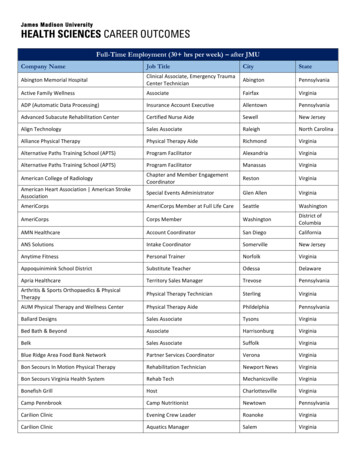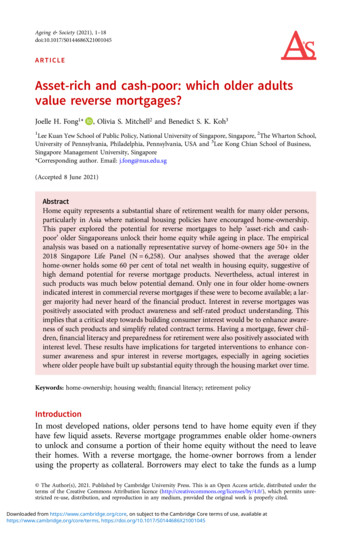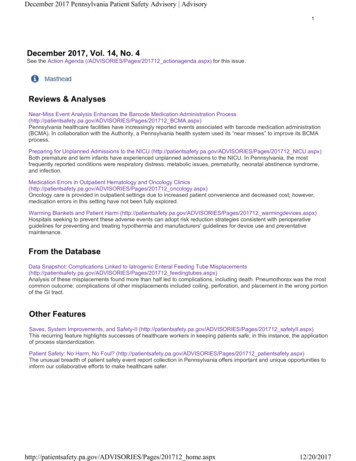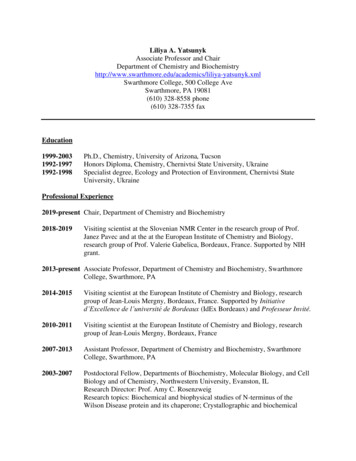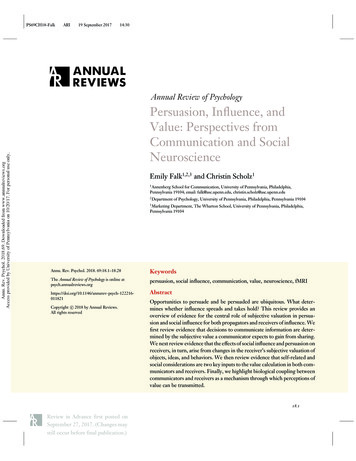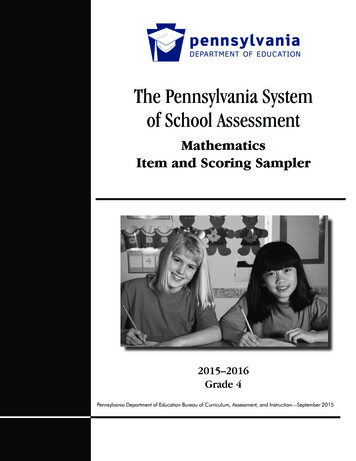
Transcription
The Pennsylvania Systemof School AssessmentMathematicsItem and Scoring Sampler2015–2016Grade 4Pennsylvania Department of Education Bureau of Curriculum, Assessment, and Instruction—September 2015
TABLE OF CONTENTSIntroduction . . . . . . . . . . . . . . . . . . . . . . . . . . . . . . . . . . . . . . . . . . . . . . . . . . . . . . . . . . . . . 1Mathematics Reporting Categories . . . . . . . . . . . . . . . . . . . . . . . . . . . . . . . . . . . . . . . . . . .2General Description of Scoring Guidelines for Mathematics Open-Ended Questions . . . . 3Description of Sample Questions . . . . . . . . . . . . . . . . . . . . . . . . . . . . . . . . . . . . . . . . . . . . 4Grade 4 Protractor . . . . . . . . . . . . . . . . . . . . . . . . . . . . . . . . . . . . . . . . . . . . . . . . . . . . . . . .4Mathematics Formula Sheet . . . . . . . . . . . . . . . . . . . . . . . . . . . . . . . . . . . . . . . . . . . . . . . . 5Multiple-Choice Questions . . . . . . . . . . . . . . . . . . . . . . . . . . . . . . . . . . . . . . . . . . . . . . . . . 7First Open-Ended Question . . . . . . . . . . . . . . . . . . . . . . . . . . . . . . . . . . . . . . . . . . . . . . . . 36Item-Specific Scoring Guideline . . . . . . . . . . . . . . . . . . . . . . . . . . . . . . . . . . . . . . . . 38First Open-Ended Question Responses . . . . . . . . . . . . . . . . . . . . . . . . . . . . . . . . . . . . . . 40Second Open-Ended Question . . . . . . . . . . . . . . . . . . . . . . . . . . . . . . . . . . . . . . . . . . . . .50Item-Specific Scoring Guideline . . . . . . . . . . . . . . . . . . . . . . . . . . . . . . . . . . . . . . . . 52Second Open-Ended Question Responses . . . . . . . . . . . . . . . . . . . . . . . . . . . . . . . . . . . 54Third Open-Ended Question . . . . . . . . . . . . . . . . . . . . . . . . . . . . . . . . . . . . . . . . . . . . . . . 64Item-Specific Scoring Guideline . . . . . . . . . . . . . . . . . . . . . . . . . . . . . . . . . . . . . . . . 66Third Open-Ended Question Responses . . . . . . . . . . . . . . . . . . . . . . . . . . . . . . . . . . . . . .68Fourth Open-Ended Question . . . . . . . . . . . . . . . . . . . . . . . . . . . . . . . . . . . . . . . . . . . . . .78Item-Specific Scoring Guideline . . . . . . . . . . . . . . . . . . . . . . . . . . . . . . . . . . . . . . . . 80Fourth Open-Ended Question Responses . . . . . . . . . . . . . . . . . . . . . . . . . . . . . . . . . . . . 82Fifth Open-Ended Question . . . . . . . . . . . . . . . . . . . . . . . . . . . . . . . . . . . . . . . . . . . . . . . . 92Item-Specific Scoring Guideline . . . . . . . . . . . . . . . . . . . . . . . . . . . . . . . . . . . . . . . . 94Fifth Open-Ended Question Responses . . . . . . . . . . . . . . . . . . . . . . . . . . . . . . . . . . . . . . 96PSSA Grade 4 Mathematics Item and Scoring Sampler—September 2015ii
INTRODUCTIONGeneral IntroductionThe Pennsylvania Department of Education provides districts and schools with tools to assist in delivering focusedinstructional programs aligned with the Pennsylvania Core Standards (PCS). These tools include AcademicStandards, Assessment Anchor documents, assessment handbooks, and content-based item and scoring samplers.This Item and Scoring Sampler is a useful tool for Pennsylvania educators in preparing local instructional programs.It can also be useful in preparing students for the statewide assessment.Pennsylvania Core Standards (PCS)This sampler contains examples of test questions that are aligned to the new Pennsylvania Core Standards-based2013 PSSA Assessment Anchors and Eligible Content. The Mathematics, Reading, and Writing PSSA transitioned toPCS-based operational Mathematics and English Language Arts assessments starting with the spring 2015 PSSAadministration.The 2013 PCS-aligned Assessment Anchor and Eligible Content documents are posted on this portal:¾¾ www.education.pa.gov [Hover over “K–12,” select “Assessment and Accountability,” and select“Pennsylvania System of School Assessment (PSSA).” Then select “Assessment Anchors” from the “OtherMaterials” list on the right side of the screen.]What Is IncludedThis sampler contains test questions (items) that have been written to align to the Assessment Anchors that arebased on the Pennsylvania Core Standards (PCS). The test questions provide an idea of the types of items that willappear on an operational, PCS-based PSSA. Each sample test question has been through a rigorous review processto ensure alignment with the Assessment Anchors.Purpose and UsesThe items in this sampler may be used as examples for creating assessment items at the classroom level, and theymay also be copied and used as part of a local instructional program.1 Classroom teachers may find it beneficial tohave students respond to the open-ended items in this sampler. Educators can then use the sampler as a guide toscore the responses either independently or together with colleagues within a school or district.Item Format and Scoring GuidelinesThe multiple-choice (MC) items have four answer choices. Each correct response to an MC item is worth one point.Each open-ended (OE) item is designed to take approximately ten to fifteen minutes to complete. During theadministration of the PSSA, students are given additional time as necessary to complete the test items. Each OEitem in mathematics is scored using an item-specific scoring guideline based on a 0–4 point scale. In this sampler,every item-specific scoring guideline is combined with examples of student responses that represent each scorepoint to form a practical, item-specific scoring guide.The sampler also includes the General Description of Scoring Guidelines for Mathematics Open-Ended Questionsthat students will have access to during a PSSA mathematics administration. The general description of scoringguidelines can be distributed to students for use during local assessments and can also be used by educators whenscoring local assessments.11The permission to copy and/or use these materials does not extend to commercial purposes.PSSA Grade 4 Mathematics Item and Scoring Sampler—September 20151
Item AlignmentAll PSSA items are aligned to statements and specifications included in the Assessment Anchors and EligibleContent Aligned to the Pennsylvania Core Standards. The mathematics content, process skills, directives, and actionstatements included in the PSSA mathematics questions align with the Assessment Anchor Content Standards. TheEligible Content statements represent the limits of the content of the mathematics questions.Testing Time and Mode of Testing Delivery for the PCS-Based PSSAThe PSSA is delivered in traditional paper-and-pencil format as well as in an online format. The estimated time torespond to a test question is the same for both methods of test delivery. During an official testing administration,students are given additional time as necessary to complete the test questions. The following table shows theestimated response time for each item type.Item TypeMCOEEstimated Response Time(in minutes)210 to 15MATHEMATICS REPORTING CATEGORIESThe Assessment Anchors are organized into four classifications, as listed below. A Numbers and OperationsB Algebraic Concepts C GeometryD Data Analysis and ProbabilityThese four classifications are used throughout the grade levels. In addition to these classifications, there are fiveReporting Categories for each grade level. The first letter of each Reporting Category represents the classification;the second letter represents the Domain as stated in the Common Core State Standards for Mathematics. Listedbelow are the Reporting Categories for Grade 4. A-T Numbers and Operations in Base Ten A-F Numbers and Operations—Fractions B-O Operations and Algebraic Thinking C-G Geometry D-M Measurement and DataExamples of multiple-choice and open-ended items assessing these categories are included in this booklet.PSSA Grade 4 Mathematics Item and Scoring Sampler—September 20152
GENERAL DESCRIPTION OF SCORING GUIDELINESFOR MATHEMATICS OPEN-ENDED QUESTIONS4 – The response demonstrates a thorough understanding of the mathematical concepts and proceduresrequired by the task.The response provides correct answer(s) with clear and complete mathematical procedures shown and acorrect explanation, as required by the task. Response may contain a minor “blemish” or omission in work orexplanation that does not detract from demonstrating a thorough understanding.3 – The response demonstrates a general understanding of the mathematical concepts and proceduresrequired by the task.The response and explanation (as required by the task) are mostly complete and correct. The responsemay have minor errors or omissions that do not detract from demonstrating a general understanding.2 – The response demonstrates a partial understanding of the mathematical concepts and proceduresrequired by the task.The response is somewhat correct with partial understanding of the required mathematical conceptsand/or procedures demonstrated and/or explained. The response may contain some work that isincomplete or unclear.1 – The response demonstrates a minimal understanding of the mathematical concepts and proceduresrequired by the task.0 – The response has no correct answer and insufficient evidence to demonstrate any understanding ofthe mathematical concepts and procedures required by the task for that grade level.Response may show only information copied from the question.PSSA Grade 4 Mathematics Item and Scoring Sampler—September 20153
DESCRIPTION OF SAMPLE QUESTIONSThe mathematics multiple-choice questions begin on page 7. Each question is preceded by the Assessment Anchorand Eligible Content coding to which it aligns. Incorrect answer options are followed by the “rationale” whichsupports the student’s response. All correct answer options are indicated by an asterisk (*).Five open-ended questions follow the multiple-choice questions. Each open-ended question includes questionspecific scoring guidelines and examples of student responses with scores and annotations.Since the PSSA is delivered in both paper-and-pencil and online formats, OE items of each method of test deliveryare included in this sampler. The online OE sample items are presented as screen shots in a landscape orientationin order to best approximate the view of a computer monitor. The examples of student responses that follow theonline OE sample items are also presented as screen shots.A calculator is permitted for use in solving questions numbered 4–50 in this sampler. Questions numbered 1–3 areto be solved without the use of a calculator. Scratch paper may be used in solving all questions, and a protractorsimilar to that shown below should be used to answer question number 50.GRADE 4 PROTRACTORThe protractor shown below is not intended to be used to measure. It has been included as a representation of theprotractors that will be provided for students when they take the test. Due to differences in printers, the protractormay not accurately reproduce to 010018001020180 17016040PSSA Grade 4 Mathematics Item and Scoring Sampler—September 2015001309014405080700011104
MATHEMATICS FORMULA SHEETBelow is a Mathematics formula sheet that will be available to students during the test. The formula sheet reflectsthe mathematical approach included in the Assessment Anchors that are based on the Pennsylvania Core Standards(PCS). The formula sheet is also available in Spanish.Formulas and conversions that you may need to work questions on this test are2016found below. You may refer back to this page at any time during the mathematics test. Grade 4Standard Conversions1 yard (yd) 3 feet (ft)1 foot 12 inches (in.)Rectanglew1 pound (lb) 16 ounces (oz.)1 gallon (gal) 4 quarts (qt)1 quart 2 pints (pt)1 pint 2 cups (c)Metric Conversions1 kilometer (km) 1,000 meters (m)1 meter 100 centimeters (cm)lArea length widthA l wPerimeter length length width widthP l l w w1 kilogram (kg) 1,000 grams (g)1 liter (L) 1,000 milliliters (mL)1111111Time Conversionsyear (yr) 12 months (mo)year 52 weeks (wk)year 365 daysweek 7 daysday 24 hours (hr)hour 60 minutes (min)minute 60 seconds (sec)PSSA Grade 4 Mathematics Item and Scoring Sampler—September 20155
PSSA MATHEMATICSOn the following pages are the mathematics questions. You may not use a calculator for questions 1–3. You may use a calculator for all otherquestions on this test. You may need a protractor for question(s) on this test.Directions for Multiple-Choice Questions:Some questions will ask you to select an answer from among four choices.For the multiple-choice questions: First solve the problem on scratch paper. Choose the correct answer and record your choice in the answer booklet. If none of the choices matches your answer, go back and check your work for possibleerrors. Only one of the answers provided is the correct response.Directions for Open-Ended Questions:Some questions will require you to write your response.For the open-ended questions: These questions have more than one part. Be sure to read the directions carefully. You cannot receive the highest score for an open-ended question without completingall tasks in the question. For example, if the question asks you to show your work orexplain your reasoning, be sure to show your work or explain your reasoning in thespace provided. If the question does not ask you to show your work or explain your reasoning, youmay use the space provided, but only those parts of your response that the questionspecifically asks for will be scored. Write your response in the appropriate location within the response box in the answerbooklet. Some answers may require graphing, plotting, labeling, drawing, or shading. Ifyou use scratch paper, be sure to transfer your final response and any needed work orreasoning to the answer booklet.PSSA Grade 4 Mathematics Item and Scoring Sampler—September 20156
PSSA MATHEMATICSMULTIPLE-CHOICE QUESTIONSQuestions 1–3 in this sampler are to be solved without the use of a calculator.A-T.2.1.31.Divide: 7,218 4A. 1,002does not do any subtraction, just divides 4 into each valueB. 1,554 R2adds 4 and 1 instead of multiplying in the first step*C. 1,804 R24 does not go into 1 in the tens place, so the student bringsdown the next place value and then dividesD. 1,840 R2A-F.2.1.72.3 foot on each side. She usedChantel made a quilt using fabric squares that measured }46 squares to make the length of the quilt. What is the length, in feet, of Chantel’s quilt?A. 1 1} 31 B. 4 }2multiplies 6 x 4, then 6 x 3 OR 6 x 3, then 6 x 4 (both derive 24/18)*3 C. 6 }4adds the values instead of multiplyingD. 8cross multiplies 6 x 4, then 1 x 3 and dividesPSSA Grade 4 Mathematics Item and Scoring Sampler—September 20157
PSSA MATHEMATICSA-F.3.1.13.3 Add: } 8 }100 1024 A. }1,000multiplies numerators and denominators11 B. }110adds numerators and denominators38 C. }10038 D. }200*converts 3/10 to 30/100, then adds numerators and denominatorsA calculator is permitted for use in solving questions numbered 4–50 in this sampler.A-T.1.1.14.A restaurant served 6,352 meals during one month. Which statement correctly compares thevalue of the digit 6 in the number of meals served with the value of the digit 3 in the numberof meals served?A. The value of the digit 6 is 2 times the value of the digit 3.ignores place valueB. The value of the digit 6 is 3 times the value of the digit 3.takes 6 – 3 and ignores place valueC. The value of the digit 6 is 20 times the value of the digit 3.*D. The value of the digit 6 is 30 times the value of the digit 3.takes 6 – 3 then uses place valuePSSA Grade 4 Mathematics Item and Scoring Sampler—September 20158
PSSA MATHEMATICSA-T.1.1.45.Mr. Coffman saw this ad for a used car in the newspaper.Car for Sale red CD player new tires runs well 126,500 miles(rounded to the nearest 100)What is the greatest number of miles that the car could have been driven?A. 126,450 milesleast number of miles that rounds to 126,500B. 126,499 milesgreatest number of miles under 126,500 that rounds to 126,500C. 126,549 milesD. 126,550 miles*least number of miles that rounds to 126,600PSSA Grade 4 Mathematics Item and Scoring Sampler—September 20159
PSSA MATHEMATICSA-T.1.1.2A-T.1.1.36.The populations of two towns are listed below.Springfield: three hundred four thousand, twentyGreenville: three hundred forty thousand, twoWhich inequality correctly compares the two populations?A. 300,420 342,000does not correctly convert from word form to number form butcompares the numbers correctlyB. 304,020 340,002 *C. 340,002 304,020converts from word form to number form correctly but does notcorrectly compare the numbersD. 342,000 300,420does not correctly convert from word form to number form anddoes not correctly compare the numbersA-T.1.1.2A-T.1.1.47.When rounded to the nearest ten thousand, Jake’s high score on a video game is170,000 points. Which could be Jake’s actual high score?A. sixteen thousand, seven hundred thirty-fivethinks this represents 167,350 instead of 16,735 and rounds correctlyB. one hundred seventeen thousand, two hundred forty-onereads this as 170,241C. one hundred sixty-two thousand, nine hundred ninety-ninemakes a rounding error, thinking this rounds up because of the 999D. one hundred seventy-three thousand, nine hundred twenty-two*PSSA Grade 4 Mathematics Item and Scoring Sampler—September 201510
PSSA MATHEMATICSA-T.2.1.18.Graham practiced piano for 135 minutes this morning. He practiced for 65 more minutes thisafternoon. Altogether, Graham practiced 10 times longer today than he practiced yesterday.How many minutes did Graham practice piano yesterday?A. 2 divides by 100B. 20 *C. 200forgets to divide by 10D. 2000multiplies by 10A-T.2.1.19.Mt. Etna is a volcano that measures 10,925 feet above sea level at its highest point. This is11,664 feet less than the height of the world’s highest volcano. What is the height, in feet, ofthe world’s highest volcano?A. 21,589does not regroup when addingB. 21,599adds from left to right with regrouping (from the hundreds place to the tens place)C. 22,581subtracts in the ones place instead of adding, adds the remaining valuesD. 22,589*PSSA Grade 4 Mathematics Item and Scoring Sampler—September 201511
PSSA MATHEMATICSA-T.2.1.1A-T.1.1.410. The number of houses in each of three cities is shown below. City 1 has 49,508 houses.City 2 has 650,279 houses.City 3 has 124,908 houses.What is the total number of houses in all three cities rounded to the nearest thousand?A. 820,000rounds to ten thousandsB. 823,000rounds each number down to thousands and then addsC. 824,000adds 3 numbers and then rounds down to thousands*D. 825,000A-T.2.1.2A-T.2.1.111. Ruth and Mari sold fruit baskets for a school fundraiser. Ruth sold 42 fruit baskets. Marisold twice as many fruit baskets as Ruth. They sold each fruit basket for 9. What is thetotal amount of money Ruth and Mari made selling fruit baskets?A. 126total number of fruit basketsB. 378amount of money Ruth madeC. 756amount of money Mari madeD. 1,134*PSSA Grade 4 Mathematics Item and Scoring Sampler—September 201512
PSSA MATHEMATICSA-F.1.1.212. Jason has a red pail and a blue pail that are the same size. The red pail is 3 full with water.}5The blue pail is } 9 full with water. Which statement best explains why the blue pail has10more water in it?A. The numerator 9 is greater than the numerator 3.ignores the denominatorsB. The denominator 10 is greater than the denominator 5.ignores the numerators3C. The fraction } is equal to } 6 , and } 6 is less than } 9 .5101010*3 .D. The difference between the numerator and the denominator in } 9 is less than it is in }510true only for fractions that have a commondenominator and are less than or equal to 1A-F.2.1.21 apple pies remaining after a party. Each of the 6 people in Kim’s family ate13. Kim’s family had 1 }4apple pie until all the apple pie was gone. Which expression could show the amount of applepie each of the 6 people in Kim’s family ate?1111A. 1 } } } } } 4 4 4 4 4does not account for all 6 people in Kim’s family12222B. 1 } } } } } } 4 4 8 8 8 8treats the 1/4s as 1/8s12222C. 1 } } } } } } 8 8 8 8 8 811122 } } } } D. 1 } }8 8 8 8 8 8*does not add the fractions correctlyPSSA Grade 4 Mathematics Item and Scoring Sampler—September 201513
PSSA MATHEMATICSA-F.2.1.31 inches long. She has a piece of14. To make a repair, Jane needs a piece of wood that is 7 }8wood that is 12 5} inches long. How many inches of wood needs to be cut off so she has8exactly 7 1} inches remaining?8A. 4 4} 8borrows from the 12B. 5just subtracts 12 74 C. 5 }86 D. 5 }8*subtracts 12 7 but adds 5/8 1/8A-F.2.1.415. In Mr. Thom’s marble collection, } 5 of the marbles are glass and } 3 of the marbles are steel.1212What fraction of the marbles in Mr. Thom’s marble collection are either glass or steel?A. 1 } 6subtracts fractionsB. 1 } 3adds numerators and denominatorsC. 5 } 8multiplies numerators and adds denominatorsD. 2 } 3*PSSA Grade 4 Mathematics Item and Scoring Sampler—September 201514
PSSA MATHEMATICSA-F.2.1.7A-F.3.1.27 of the16. A fruit drink is made from orange juice and pineapple juice. Orange juice makes up }10fruit drink. What is the amount of orange juice in 8 gallons of the fruit drink?A. 1.5 gallonsB. 5.6 gallonsincorrect fraction (15/10), correct conversion*C. 15 gallonsincorrect fraction (15/10), incorrect conversionD. 56 gallonscorrect fraction (56/10), incorrect conversionA-F.3.1.1A-F.3.1.217. On Jenny’s farm } 48 of the trees are pine trees and } 3 of the trees are birch trees. What10010decimal number is equal to the fraction of the trees on Jenny’s farm that are either pinetrees or birch trees?A. 0.051incorrect sum of 51/100 and incorrect placement of decimal pointB. 0.078correct sum of 78/100 but incorrect placement of decimal pointC. 0.51incorrect sum of 51/100 but correct placement of decimal pointD. 0.78*PSSA Grade 4 Mathematics Item and Scoring Sampler—September 201515
PSSA MATHEMATICSA-F.3.1.2A-F.3.1.1A-F.2.1.318. Ramon bought 2.03 pounds of grapes last week. He bought 1.1 pounds of grapes this week.Which number sentence shows how many pounds of grapes Ramon bought in all?3 1 1 3 4 A. 2 }}}101010converts 2.03 incorrectly3 1 1 3 4 B. 2 }}}10010110adds denominators3 1 1 3 4 C. 2 }}}100100100converts 1.1 incorrectly3 1 10 3 13 D. 2 }}}100100100*A-F.3.1.319. Which statement correctly compares 10.26 and 10.35?A. Since 2 6 8 and 3 5 8, 10.26 10.35.adds the numbers after the decimal together to establish their valuesB. Since the whole numbers are the same, 10.26 10.35.compares the whole values correctly, but stops thereC. Since the 2 in the tenths place is less than 3, 10.26 10.35.*D. Since the 6 in the hundredths place is greater than 5, 10.26 10.35.compares the decimal values from right to left instead of left to rightPSSA Grade 4 Mathematics Item and Scoring Sampler—September 201516
PSSA MATHEMATICSB-O.1.1.120. Leo and Rachel have boxes of chalk. Leo has 6 boxes with 8 pieces in each box.Rachel has 8 boxes with 6 pieces in each box.Which number sentence correctly shows the relationship between the total number of piecesof chalk in Leo’s and Rachel’s boxes?A. 6 8 8 6uses addition instead of multiplicationB. 6 8 8 6chooses the inequality sign based on thefirst number in each addition expression*C. 6 8 8 6chooses the inequality sign based on thefirst number in each multiplication expressionD. 6 8 8 6B-O.1.1.2B-O.3.121. Claire writes a number pattern that starts with 5 and follows the rule “multiply by 2.” Megwrites another number pattern. The fourth number in Meg’s pattern is 6 times as large asthe fourth number in Claire’s pattern. Which expression is equal to the fourth number inMeg’s pattern?A. 6 30starts with 5 and multiplies by 2, so thinks patterns are the 10s (5, 10, 20, 30, .) and thenadds instead of multipliesB. 6 40adds instead of multipliesC. 6 30starts with 5 and multiplies by 2, so thinks patterns are the 10s (5, 10, 20, 30, .)D. 6 40*PSSA Grade 4 Mathematics Item and Scoring Sampler—September 201517
PSSA MATHEMATICSB-O.1.1.322. Peter, Ingrid, and Anna collect posters. Peter has 14 posters. Ingrid has 6 more posters thanPeter. Anna has 3 times as many posters as Ingrid. How many posters do Peter, Ingrid, andAnna have altogether?A. 46uses 8 posters (14 – 6) for Ingrid and 24 posters (3 8) for AnnaB. 76uses 42 posters (3 14) for Anna*C. 94D. 104uses 42 posters (3 14) for Anna and 48 posters (42 6) for IngridB-O.1.1.323. Omar has 25 books. Nan has 3 times as many books as Omar. Nan stores her books in boxesthat hold 6 books each. She fills as many boxes as she can and puts the remaining books ona shelf. How many books does Nan put on the shelf?A. 1B. 3divides 25 by 6*C. 4divides 28 by 6 (thinks Nan has 3 more books than Omar)D. 5interprets the 5 in 12.5 as 5 remaining booksPSSA Grade 4 Mathematics Item and Scoring Sampler—September 201518
PSSA MATHEMATICSB-O.1.1.3B-O.1.1.124. On vacation, Lou took p photographs. He used 4 times as many memory cards as Kathy.Kathy used 2 memory cards and each card contained 240 photographs. Which equationshows how many photographs ( p) Lou took while on vacation?A. 4 p 2 240interprets “4 times as many” as “4 ” ANDswitches Lou’s amount with Kathy’s amountB. 4 2 240 pinterprets “4 times as many” as “4 ”C. 4 p 2 240switches Lou’s amount with Kathy’s amountD. 4 2 240 p*B-O.1.1.425. Mr. Jones has 50 paintbrushes to give to each of his two art classes. His first class has 7 students.His second class has 9 students.During class, Mr. Jones gives each student the same number of paintbrushes. He gives out asmany paintbrushes as possible. He then writes the statement shown below to compare thenumber of paintbrushes he has remaining from each class.number remaining from the first classWhat symbol should go into theA. number remaining from the second classto make the comparison true?*B. uses the inequality sign to point to the larger number ORthinks 50 7 50 9C. thinks Mr. Jones will have 0 brushes left from each class, notnoticing that neither 7 nor 9 goes into 50 evenlyD. division is used in the problem but not for the comparisonPSSA Grade 4 Mathematics Item and Scoring Sampler—September 201519
PSSA MATHEMATICSB-O.2.1.126. How many numbers are both multiples of 4 and factors of 36?A. 0thinks numbers cannot be both multiples and factors of different valuesB. 1thinks only 4 (or 36) fits the criteriaC. 2thinks only 4 and 36 fit the criteriaD. 3*B-O.3.127. Paula starts making a pattern by drawing the shapes shown below.Shape 1Shape 2Shape 3Shape 4The pattern continues. How many sides will Shape 20 have?A. 17subtracts 3 from the shape numberB. 20thinks the number of sides is equal to the shape numberC. 22adds 2 to the shape numberD. 23*PSSA Grade 4 Mathematics Item and Scoring Sampler—September 201520
PSSA MATHEMATICSB-O.3.1.228. Jarod keeps his coin collection in a coin book. The table below shows the total number ofcoins he has stored based on the number of pages with coins.Coin CollectionNumberof PagesNumberof Coins31874211661590How many coins does Jarod store on each page of the book?A. 4B. 6pattern from the left column*C. 18first number in the “Number of Coins” columnD. 24pattern from the right columnPSSA Grade 4 Mathematics Item and Scoring Sampler—September 201521
PSSA MATHEMATICSB-O.3.1.2B-O.3.1.329. Mrs. Lawson plants the same number of flowers in her garden each week. The table belowshows the total number of flowers in her garden at the end of weeks 2, 3, and 4.Mrs. Lawson’s GardenWeekNumber ofFlowers283124165?The pattern continues. Which number sentence could be used to find the number of flowersin Mrs. Lawson’s garden at the end of week 5?A. 5 4 9recognizes a pattern (add 4) but adds it to WeekB. 5 12 17since 4 12 16C. 5 4 20D. 5 5 25*since 4 x 4 16PSSA Grade 4 Mathematics Item and Scoring Sampler—September 201522
PSSA MATHEMATICSB-O.3.1.330. The cost for Akito to call his aunt in Japan is shown in the table below.Cost of Phone CallTime(minutes)Cost(cents)110220330440Which pair of equations show two different ways Akito could find the cost to call his aunt for5 minutes?A. 40 40 80 and 40 2 80thinks the amount doubles each time, just looking at the first twovalues in the tableB. 40 5 45 and 5 9 45thinks the previous cost should be added to the number of minutes(and then comes up with a multiplication equation to match)C. 40 10 50 and 5 10 50*D. 40 160 200 and 40 5 200thinks the previous cost should be multiplied by 5 (and then comesup with an addition equation to match)PSSA Grade 4 Mathematics Item and Scoring Sampler—September
(in minutes) 2 10 to 15 MATHEMATICS REPORTING CATEGORIES The Assessment Anchors are organized into four classifications, as listed below. A Numbers and Operations C Geometry B Algebraic Concepts D Data Analysis and Probability These four classifications are used throughout the grade


